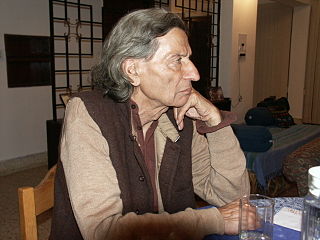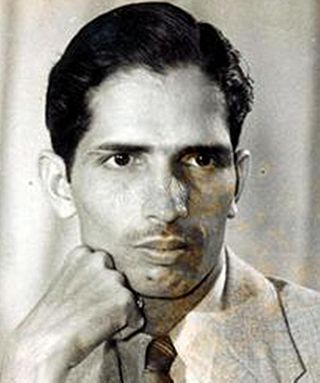Related Research Articles

Sunil Dutt was an Indian actor, film producer, director and politician. Dutt was one of the major stars of Hindi cinema in the late 1950s and 1960s and continued to star in many successful films which included Mother India (1957) Sadhna (1958), Insan Jaag Utha (1959), Sujata (1959), Mujhe Jeene Do (1963), Gumraah (1963), Waqt (1965), Khandan (1965), Mera Saaya (1966) and Padosan (1967), and Hamraaz (1967), Heera (1973), Pran Jaye Par Vachan Na Jaye (1974), Nagin (1976), Jaani Dushman (1979), Muqabla (1979), and Shaan (1980). In 1968, he was honoured by the Padma Shri by the Government of India. He is the father of popular actor Sanjay Dutt.

Maqbool Fida Husain was an Indian artist known for executing bold, vibrantly coloured narrative paintings in a modified Cubist style. He was one of the most celebrated and internationally recognised Indian artists of the 20th century. He was one of the founding members of Bombay Progressive Artists' Group. M.F. Husain is associated with Indian modernism in the 1940s. His early association with the Bombay Progressive Artists' Group used modern technique, and was inspired by the "new" India after the partition of 1947. His narrative paintings, executed in a modified Cubist style, can be caustic and funny as well as serious and sombre. His themes—sometimes treated in series—include topics as diverse as Gandhi, Mother Teresa, the Ramayana, the Mahabharata, the British Raj, and motifs of Indian urban and rural life. In September 2020, his painting titled “Voices”, auctioned for a record $2.5 million.

Twinkle Khanna is an Indian author, columnist, interior designer, film producer and a former film actress.

Balraj Sahni was an Indian film and stage actor, who is best known for Dharti Ke Lal (1946), Do Bigha Zameen (1953), Chhoti Bahen (1959), Kabuliwala (1961) and Garam Hawa (1973). He was the brother of Bhisham Sahni, noted Hindi writer, playwright, and actor.
Balraj Puri (1928-2014) was an Indian Political commentator and human rights activist.

Aa Ab Laut Chalen is a 1999 Indian Hindi language romantic drama directed by Rishi Kapoor, making his directorial debut and also remains the only film he had directed in his career. The film's script was written by Sachin Bhowmick and Rumi Jaffery. The film premiered in India and the United States on 22 January 1999. It starred Rajesh Khanna, Akshaye Khanna, and Aishwarya Rai and was the last production of R. K. Films.

Julio Francis Ribeiro is a retired Indian police officer and civil servant. He held increasingly responsible positions during his career, and led the Punjab Police during part of the Punjab insurgency periods. In 1987, he was awarded the Padma Bhushan, India's third highest civilian award for his services.
Khanna is a Khatri clan of the Dhai Ghar community.

Pratiksha Apurv is an Indian painter, whose work is based on her uncle Bhagwan Shree Rajneesh (Osho)'s teachings. Before moving to painting, she was a successful fashion designer. Apurv won the National Award 2015-16 given by the Lalit Kala Akademi, Ministry of Culture for her painting 'Cosmic Balance', and has exhibited her artwork across the country. Her artwork has featured in books and magazines, and in 2018 she wrote and illustrated her own book, The Mystic and Her Colours.

Keshav Malik was an Indian poet, art and literary critic, arts scholar, and curator. He remained art critic for the Hindustan Times (1960–1972) and The Times of India (1975–2000). He published eighteen volumes of poetry and edited six anthologies of English translations of Indian poetry.

Kattingeri Krishna Hebbar was an Indian painter and art educator. He is well known for his paintings that captured the social life of the common people in India. Inspired by traditional Indian art, he combined the Western art techniques with his paintings to create a unique style of his own. Painting for Hebbar was about being true to the original self and this is what he tried to achieve in his works. In addition to his paintings, he is also known for his rhythmic line drawings and illustrations.

Jehangir Sabavala was an Indian painter.
Gayatri Sinha is an art critic and curator based in New Delhi, India. Her primary areas of research are around the structures of gender and iconography, media, economics and social history. She founded Critical Collective, a forum for thinking about conceptual frames within art history and practice in contemporary India.
Amar Nath Sehgal was a noted Indian modernist sculptor, painter, poet and art educator. He started his career as an engineer in Lahore, and later turned to art. He shifted to Delhi after partition of India in 1947, and in 1950 studied art education from New York University School of Education. Subsequently, became an art educator, teaching at College of Art, Delhi, and in time a noted modern sculptor to his generation. Though he also ventured into painting, drawings and poetry.

Lalit Kala Academy
Bishamber Khanna is an Indian painter and enamelist. Born in 1930, Khanna is credited with several exhibitions and his creations have been displayed at centres such as the Delhi Art Gallery. He served as a member of the jury for the 20th National Film Awards and the 22nd National Film Awards.
Brijinder Nath Goswamy is an Indian art critic, art historian and a former vice chairman of the Sarabhai Foundation of Ahmedabad, which runs the Calico Museum of Textiles. Goswamy is best known for his scholarship on Pahari painting and Indian miniature paintings. He is the author of over 20 books on arts and culture, including Sakti Burman: A Private Universe, a monograph on the life and works of Sakti Burman, renowned Bengali painter and Masters of Indian Painting 1100-1900, a treatise on Indian miniature art. The Government of India awarded him the fourth highest civilian award of the Padma Shri in 1998 and followed it up with the third highest honour of the Padma Bhushan in 2008.

Prabhakar Barwe was a pioneer of Modern Indian painting. He was active in Mumbai, India from the 1959 until his death in 1995. Influenced by the esoteric tradition of Tantric painting, Barwe along with G. R. Santosh, P. T. Reddy, K.C.S. Paniker, Biren De, Om Prakash, K. V. Haridasan, Prafulla Mohanti and Mahirwan Mamtani was considered part of the modernist movement Neo-Tantra.

Arvind Khanna is an Indian politician, business magnate and philanthropist. He is a member of the Bharatiya Janata Party (BJP). Khanna is a senior leader of the BJP and a prominent figure in BJP Punjab. He is serving as Vice-President of BJP Punjab since December 2022. Khanna is noted politically for his financial resources and philanthropy. He served as the member of legislative assembly (MLA) from Sangrur from 2002 to 2007 and the MLA from Dhuri from 2012 to 2014. He has also served as the General Secretary of the Punjab Pradesh Congress Committee (PPCC) and as the PPCC treasurer.
References
- ↑ Tejpal, Tarun J (15 September 1991). "Book review: Balraj Khanna's 'Sweet Chillies'". India Today. Retrieved 9 August 2019.
- ↑ Dutt, Robin (17 June 1994). "Alchemical variations: Balraj Khanna became a painter by accident, but his canvases are unique symbolic fusions of colour and form". The Independent. Retrieved 9 August 2019.
- ↑ Dunn, John (11 May 1999). "Art is the lease they can do". The Guardian. Retrieved 9 August 2019.